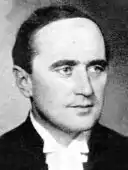Elias Simojoki
Lauri Elias Simojoki (28 January 1899 – 25 January 1940) was a Finnish clergyman who became a leading figure in the country's far right movement.
Elias Simojoki | |
|---|---|
 | |
| Born | Lauri Elias Simelius 28 January 1899 |
| Died | 25 January 1940 (aged 40) |
| Cause of death | Gunshot wound |
| Citizenship | Finnish |
| Occupation | Priest |
| Known for | Political activist |
| Title | Head of Sinimustat |
| Term | 1933-1936 |
| Political party | Patriotic People's Movement |
The son of a clergyman, Simojoki was born on 28 January 1899 in Rautio.[1] As a youth he saw service in the struggle for Finnish independence and then with the Forest Guerrillas in East Karelia.[1] A student in theology at the University of Helsinki, he became involved in the formation of Academic Karelia Society, serving as chairman from 1922-3 and secretary from 1923-4.[1] He advocated the union of all Finnish people into a Greater Finland whilst in this post.[1] Strongly influenced by Russophobia, the student Simojoki addressed a rally on 'Kalevala Day' in 1923 with the slogan "In the name of Finland's lost honour and her coming greatness, death to the Ruskis."[2]
Simojoki was ordained as a minister in 1925 and he held the chaplaincy at Kiuruvesi from 1929 until his death.[1] He became involved with the Patriotic People's Movement and, in 1933, took command of their youth movement, Sinimustat (The Blue-and-Blacks), which looked for inspiration to similar movements amongst fascist parties in Germany and Italy.[1] The movement was banned in 1936 due to its involvement in revolutionary activity in Estonia, although Simojoki continued to serve as a leading member of the Patriotic People's Movement.[1] He was a Member of Parliament in 1933-1939. He founded a second youth group, Mustapaidat (the Black Shirts), in 1937, although this proved less successful.[1]
When the Winter War broke out in 1939 Simojoki enlisted as a chaplain in the Finnish Army.[1] He was killed in action on Koirinoja's ice in Impilahti, while putting down a wounded horse in no man's land. After the Finnish troops were unable to put down the horse from their positions, Simojoki skied to the horse and euthanized it with a pistol. Having done that, he was gunned down by a Soviet machine gun.[3]
References
- Philip Rees, Biographical Dictionary of the Extreme Right Since 1890, Simon & Schuster, 1990, p. 359
- Christopher S. Browning, Constructivism, Narrative and Foreign Policy Analysis: A Case Study of Finland, Peter Lang, 2008, p. 129
- Virkkunen, Sakari (1975). Elias Simojoki – legenda jo eläessään. WSOY. p. 218. ISBN 951 0-06258-8.